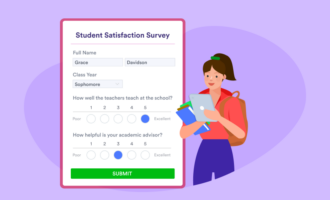Steps for starting a petition at school
- Identify the issue
- Do your research
- Start writing your petition
- Gather support and collect signatures
- Engage with decision-makers
- Follow up with all stakeholders
Whether you’re a student advocating for more extracurricular activities, a parent wanting your child to have healthier school lunches, or a teacher needing more classroom resources, sometimes the best way to create change in educational settings is to start a petition.
A petition lets you share information about your cause with people who may have similar thoughts and opinions, and it offers them a way to show their support.
To ensure your school petition is effective, you need to go about it in the right way. Building an effective, well-researched petition that’s easy to view and sign will help you gather the most support.
Wondering how to start a petition at school? This article will walk you through step-by-step instructions to get your petition off the ground. We’ll also share helpful tips from experts who have led successful petition efforts at schools. Finally, we’ll talk about how you can use Jotform to build a school petition.
How to start a petition at school: Step-by-step instructions
Whether you’re building a petition calling for more resources or a school policy change, you should start with careful planning and a methodical approach.
Vasilii Kiselev, one of the cofounders of Legacy Online School, an accredited online school with homeschool programs, shared how his students initiated a petition for extracurricular activities.
“Initially we assisted the students in outlining the issue and pinpointing the changes they sought. Their focus was on introducing clubs centered around creativity and technology. The students conducted research on programs in schools and conducted surveys to gauge student interest,” says Kiselev.
“The students reached out to [other] students, teachers, and parents who shared their passion. This backing lent credibility to their petition. Together, the students crafted a statement detailing the problem, its repercussions, and their proposed remedy along with a call to action.”
After that, it was time to create an official document for supporters to sign. “Utilizing Jotform, we established a platform for the petition to facilitate distribution and signature collection. Promotion played a role; leveraging media, school bulletins, and community gatherings helped spread awareness,” says Kiselev.
“With signatures pouring in, the students monitored their progress closely while setting a deadline. Upon submission of the petition, they confidently presented it to the school board accompanied by a letter and meeting request. In the end, our efforts paid off, as the petition was successful. The school board gave approval for extracurricular activities, showcasing to our students the impact of advocacy and thorough preparation.”
Want to get the same results with your school petition? Here’s how!
Identify the issue
The first step to building a successful petition is clearly identifying the cause you want to promote. Dalya Harel, founder of Lice Busters, a head lice removal and treatment service, says, “For us, it was ensuring regular lice checks to protect children’s health.”
In order to ensure their petition was successful, Harel focused on transparency. “Clearly communicate the purpose of the petition and how the proposed solution will benefit the school community,” she advises.
Your supporters and stakeholders need to know exactly what you’re fighting for. If it’s murky, you may not get their support.
Do your research
Next up, it’s time to roll up your sleeves and research the cause. Why is a petition necessary? Why hasn’t the issue been resolved already? Has anyone else already tried to resolve it — and if so, why weren’t they successful? Asking these types of questions is a good way to get started.
“I remember when my kids wanted healthier lunch options and we decided to start a petition,” says Stephanie Edenburgh, CEO of Bizzie Mommy, an online resource for parents. “It’s important to do some research and gather facts to support your cause. This way, you can present a strong case that highlights the benefits of your proposal.”
Where possible, include statistics that support your argument as well as real-life stories from people who are affected.
Start writing your petition
Once you have all of your research in hand, you can begin crafting your arguments. “Write a clear, concise petition statement outlining the problem, the proposed solution, and the benefits,” says Harel. “Make sure it’s easy to understand and compelling.”
Your written argument will help convince people to sign your petition. It’s also what decision-makers will consider when reviewing your proposal. The stakes are high, so be sure to spend time crafting a strong argument.
Gather support and collect signatures
Once you’ve developed a clear and compelling petition, it’s time to appeal to the right audience: the people who may share your passion for the cause and want to sign the petition. This can include students, teachers, parents, administrative staff, members of the community, school board staff, and others.
“Decide whether you want to create a physical paper petition or use an online platform like Jotform,” says Harel. “Online platforms can make it easier to collect and manage signatures.”
Try to get as many eyes on the petition as possible. “Share the petition through various channels such as school newsletters, PTA meetings, social media, and word of mouth,” says Harel. “Ensure everyone in your network is aware and understands the importance of signing it.”
Engage with decision-makers
While you’re collecting your signatures, you’ll also need to set up meetings with decision-makers to discuss the issue. They may include teachers or administrators at the school or school board officials. They could also be parents or students. Regardless, it’s best to keep them informed about your petition and let them know that you’re working on collecting support from people in the school community.
“When we started our petition, we organized small meetings and used social media to spread the word,” says Edenburgh. “I think presenting the petition to school authorities should be done respectfully and professionally. I suggest setting up a meeting with the principal or relevant decision-makers. Be prepared to discuss your petition and provide any supporting documents.”
Harel echoes the need for respect. “Approach the administration with respect and a collaborative attitude. Positivity can go a long way in getting your message across.”
Follow up with all stakeholders
After you’ve successfully collected the signatures and presented your petition to those in charge, be sure to follow up. Update supporters about how the issue is progressing. Follow up with those in charge to ensure that the issue stays top of mind and doesn’t get buried under administrative red tape.
Harel says you should prepare for opposition in certain cases. “Anticipate counterarguments and prepare thoughtful responses to address concerns.”
Edenburgh notes that it’s important to keep your cool and focus on the relationship with stakeholders when discussing your petition: “To avoid pushback, I think it’s essential to remain polite and open to dialogue. Address any concerns or objections calmly and provide well-researched answers. Building a good relationship with school authorities can go a long way in getting your petition considered seriously.”
Frame your arguments to show how the change you’re calling for will benefit all stakeholders.
“When we organized a petition for lice checks, we emphasized that it wouldn’t affect the school budget, as Lice Busters offered to provide the service at a discounted rate or even for free during peak infestation periods,” says Harel. “We highlighted the health benefits and reduced absenteeism, which resonated well with both parents and school officials.”
How Jotform can make the school petition process easier
Ready to get going now that you know how to start a petition at school? Jotform is an online form builder that comes with petition templates you can customize to fit your needs with an easy-to-use, drag-and-drop interface. You can also quickly build a brand new petition from scratch.
You can add an electronic signature field to your online petition form so you don’t have to print out the form to collect signatures — making it a lot easier for supporters to sign your petition, wherever they are.
Jotform can be adopted as an educational technology solution in other ways. Jotform Enterprise is a powerful way for schools to manage forms and data. Jotform tools can help educators automate school processes, such as admissions, enrollment, and attendance tracking.
Jotform is free to try. Educational institutions can also save 50 percent on paid plans and 30 percent on Jotform Enterprise.
Photo by Max Fischer








































































































Send Comment: